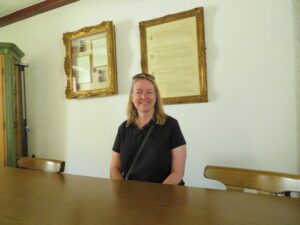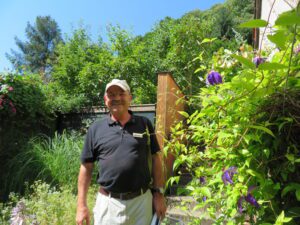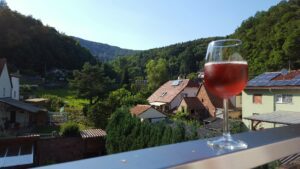A Village of Quiet Charm

My 2016 visit to Graefenhausen was so much better than my 1999 visit. Instead of standing outside the town hall, I got to sit in the mayor’s chair!
My 1999 visit to Gräfenhausen (origin of my Billigmeier family) epitomizes what not to do when visiting an ancestral town. I showed up there one afternoon, completely unplanned. I stood on the street, looked around, didn’t talk to anyone (didn’t actually see anyone to talk to), took a photo of a building that looked important, stood in the cemetery (no Billigmeier graves), then left. I was probably there about 20 minutes in total.
Visiting last week was a completely different experience, thanks to the warmth and hospitality of the people of Gräfenhausen. The visit helped me fall in love with the quiet charm of this small village, tucked into a wooded valley north of Annweiler.
Herr Unger, a life-long resident, gave me a glimpse into the life and history of Gräfenhausen, his love for his home village shining through with every word. And fortunately, Herr Koelsch, who runs the Annweiler Heimatmuseum, assisted both with translation and by giving me additional background on the history of the area.
I was welcomed into that “important-looking” building (the town hall) that I’d taken a photo of 17 years ago, and seated in the mayor’s seat. (Although technically, Gräfenhausen is part of Annweiler and run by its mayor, the village does have its own community leader.) Herr Unger pulled out a bottle of local wine and we sipped a lovely red as we talked over 500 years of history.
It’s a small town, without jaw-dropping sights to see. Instead, I got a very personal glimpse of life there as Herr Unger pointed out the historic-looking homes of his parents, grandparents, and cousins. As he showed me the stables, garden, and smokehouse, his description painted a picture of a family growing up in small-town Germany after WWII.
Going back to my ancestors’ time, I learned how this area had been occupied by the French in the late 1700s, and how hard life had been in the early 1800s despite the end of the French occupation—no doubt the reason that free land in Ukraine was an attractive enough offer to entice my family to travel 1,400 miles east.
I learned that there was no Protestant church in the village at that time, and imagined my ancestors walking a little over a mile each Sunday down the valley to the church in Queichhambach. I learned how methodical the farmers of Gräfenhausen were—wine grapes planted on one side of the valley and all other crops planted on the other side. I discovered that there was a book about the history of Gräfenhausen and I was actually in the village long enough to purchase one (from the one store in town, which is only open 6 a.m. to 11 a.m.).
My hosts in my Ferienwohnung (vacation apartment) in a local winery were warm and welcoming (and happened to be cousins of Herr Unger), curious about my centuries-old connection to their town. They got very engaged in helping me look for possible Billigmeier families (unfortunately, only a few in the online telephone directory and even those with a different spelling) hoping to help me find distant cousins.
My only regret was that the local Gasthof, a restaurant with small beer garden, was closed due to the owner’s illness. I’d had visions of drinking beer with the locals and getting to know a few more people, embracing daily life in the village if only for an evening.
Gräfenhausen sits at the end of the road, up against the wooded slopes of the surrounding hills. No one ends up in Gräfenhausen accidentally—it’s not on the way to anywhere. It seems a remote location and is—most people living there work in the city of Landau, about 10 miles away. Gräfenhausen residents are often asked why they stay, why they don’t move nearer work and the city. But the small community is a close-knit one, with families whose roots stretch back dozens, sometimes hundreds, of years. Its quiet charm is causing it to grow (lots of new construction happening) despite its remote location because people want to experience that quiet sense of community.
I finished my day sitting on the deck, sipping a chilled local rosé, and listening to the shouts from a soccer match and post-game party at the community center. It made me wish that my connection to this community was a little closer than 200 years.

